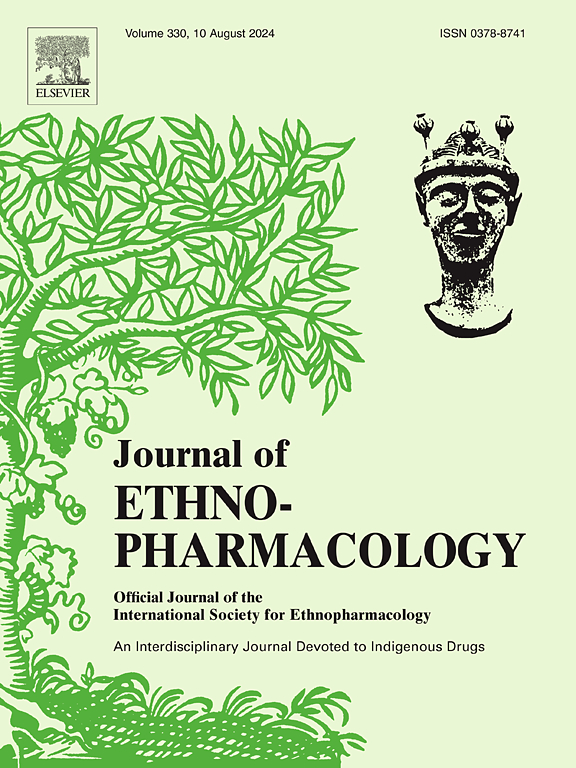藏红花提取物通过激活PI3K-Akt-Nrf2信号通路减轻d -gal诱导的晚发性性腺功能减退。
IF 4.8
2区 医学
Q1 CHEMISTRY, MEDICINAL
引用次数: 0
摘要
民族药理学相关性:迟发性性腺功能减退(LOH)是男性中一种常见的与年龄有关的疾病,其特征是血清睾酮水平下降以及一系列相关体征和症状,在传统医学中被归类为阳痿。藏红花是藏红花(Crocus sativus L.)的干柱头,在传统医学中用作壮阳药。研究目的:采用衰老小鼠模型和间质细胞,探讨藏红花提取物(SE)对LOH的影响。方法:首次利用网络药理学方法确定SE治疗LOH的潜在机制和治疗靶点。通过给药d -半乳糖诱导小鼠衰老模型,然后用不同浓度的SE治疗。随后对血清睾酮水平、精液质量、睾丸老化、氧化应激和凋亡标志物进行评估,以评估SE的影响并阐明其机制。此外,体外实验评估了SE对间质细胞活力、氧化应激和凋亡的影响。结果:结果显示,SE可调节PI3K-Akt-Nrf2信号通路,增强间质细胞抗氧化应激能力,减少间质细胞凋亡,从而改善间质细胞功能,缓解血清睾酮与衰老相关的下降。结论:藏红花是治疗LOH的有效方法,可有效缓解老年男性血清睾酮水平下降。本文章由计算机程序翻译,如有差异,请以英文原文为准。

Saffron extract alleviates D-gal-induced late-onset hypogonadism by activating the PI3K-Akt-Nrf2 signaling pathway
Ethnopharmacological relevance
Late-onset hypogonadism (LOH) is a common age-related condition in men, characterized by a decline in serum testosterone and a range of associated signs and symptoms, and is classified as impotence in traditional medicine. Saffron is the dried stigma of Crocus sativus L., which is used in traditional medicine as an aphrodisiac.
Aim of the study
This study aimed to investigate the effects of saffron extract (SE) on LOH using an aging mouse model and Leydig cells.
Methods
The potential mechanisms and therapeutic targets of SE for the treatment of LOH were first identified using network pharmacology. An aging model was induced in mice by administration of D-galactose, followed by treatment with varying concentrations of SE. Subsequent assessments of serum testosterone levels, semen quality, testicular aging, oxidative stress, and apoptotic markers were performed to assess the impact of SE and to elucidate its mechanisms. In addition, in vitro experiments assessed the effect of SE on Leydig cell viability, oxidative stress, and apoptosis.
Results
The results showed that SE could modulate the PI3K-Akt-Nrf2 signaling pathway, enhancing Leydig cell resistance to oxidative stress and reducing Leydig cell apoptosis, thereby improving Leydig cell function and alleviating the decrease in serum testosterone associated with aging.
Conclusion
Saffron is a promising strategy for the treatment of LOH and provides an effective approach to alleviate serum testosterone decline in older men.
求助全文
通过发布文献求助,成功后即可免费获取论文全文。
去求助
来源期刊

Journal of ethnopharmacology
医学-全科医学与补充医学
CiteScore
10.30
自引率
5.60%
发文量
967
审稿时长
77 days
期刊介绍:
The Journal of Ethnopharmacology is dedicated to the exchange of information and understandings about people''s use of plants, fungi, animals, microorganisms and minerals and their biological and pharmacological effects based on the principles established through international conventions. Early people confronted with illness and disease, discovered a wealth of useful therapeutic agents in the plant and animal kingdoms. The empirical knowledge of these medicinal substances and their toxic potential was passed on by oral tradition and sometimes recorded in herbals and other texts on materia medica. Many valuable drugs of today (e.g., atropine, ephedrine, tubocurarine, digoxin, reserpine) came into use through the study of indigenous remedies. Chemists continue to use plant-derived drugs (e.g., morphine, taxol, physostigmine, quinidine, emetine) as prototypes in their attempts to develop more effective and less toxic medicinals.
 求助内容:
求助内容: 应助结果提醒方式:
应助结果提醒方式:


